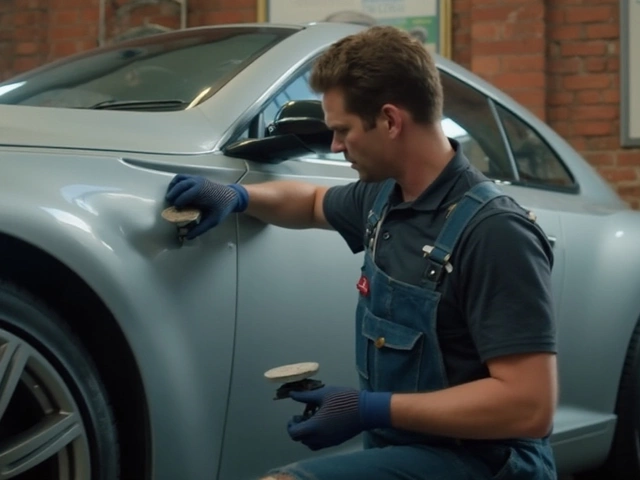Imagine pulling away from a stoplight. You step on the gas, your RPMs climb, but your car barely moves. Or, maybe your shifter refuses to slide smoothly into gear, like it's caught on something. You know something's wrong, but the real question is—are you looking at a clutch disaster or a transmission meltdown? Figuring this out could mean the difference between a simple fix and a wallet-busting repair bill.
How the Clutch and Transmission Actually Work Together
The weird thing is, most drivers never really think about what connects their foot to the wheels. The clutch and transmission aren’t just mysterious boxes under the floorboard—these parts share a complicated dance every time you drive. In a manual car, your left foot operates the clutch pedal, which temporarily disconnects the engine from the wheels to let you shift gears. It's like pausing the action for a second so you can change the rules.
The clutch is made up of a pressure plate, clutch disc, and flywheel. When you push the pedal, you’re separating the clutch disc from the flywheel, so power isn’t sent to the transmission. This lets you pick a new gear without crunching or grinding metal. As you release the pedal, everything clamps back together and the car moves.
The transmission handles the next part—it actually changes the gear ratio, so your engine and wheels can turn at different speeds. Manual transmissions use gear clusters and synchronizers. Automatics use planetary gears, bands, and hydraulics. Either way, if the clutch slips or won’t disengage, shifting gears gets tricky or impossible. If the transmission itself is the culprit, you might hear grinding, clunking, or even get stuck in gear.
Knowing the difference saves time and helps explain the problem to a mechanic. If you describe the symptoms right, you’ll sound like an expert instead of someone getting ready to empty their savings account for “mystery labor.”
Classic Signs: Clutch Trouble vs Transmission Issues
The symptoms can be frustratingly similar, but there are telltale differences. Let’s break it down:
If your clutch is the problem, it usually shows up as:
- Difficulty shifting, especially into first or reverse
- RPMs jump, but car doesn’t accelerate as much—classic clutch slip
- A burning smell after stop-and-go traffic or hill starts
- The clutch pedal feels soft, spongy, or sinks to the floor
- A grinding noise when trying to engage gears—especially if the pedal is pressed in
If your transmission is acting up, look out for:
- Gearbox makes awful grinding even when clutch is fully down
- Shifter gets stuck between gears or pops out randomly
- Whining or clunking noise from under center console
- Leaking red or brown fluid (manuals use gear oil, automatics use ATF)
- Warning lights for transmission or check engine
If you’re not sure, try this: With the engine running and the clutch pedal all the way down, try shifting through each gear. If it fights back or makes noise, clutch may be dragging. If you let out the clutch slowly in first gear with a little throttle and the engine revs like crazy but you barely move, your clutch is slipping.
Here’s something most people don’t realize: The average clutch lasts about 60,000 to 100,000 miles, but transmissions can often last the lifetime of the car—with regular maintenance. Abuse, like riding the clutch or “power shifting,” fries these components way faster.
Now check out this quick reality check on costs and lifespans:
| Part | Average Lifespan (Miles) | Replacement Cost (USD) |
|---|---|---|
| Clutch Kit | 60,000–100,000 | $800–$1,500 |
| Manual Transmission | 120,000–180,000 | $1,800–$3,400 |
| Automatic Transmission | 100,000–160,000 | $2,300–$5,500 |

Pinpointing the Fault: DIY Tips and Simple Tests
You don’t need fancy gear to spot the most common problems. A little curiosity goes a long way.
Start by inspecting the clutch pedal feel. Does it push down softly but doesn’t spring back as expected? Could be a worn hydraulic master or slave cylinder. If you see brake fluid leaking onto your shoes, that’s a smoking gun. Sometimes you’ll notice the clutch engagement point has drifted—it bites right at the floor or way too high. This isn’t a magical sign from the car gods. It usually means the clutch disc is worn or cable adjustment is off (if you don’t have hydraulics).
Noise can help, too. Try this: With the engine idling in neutral, press the clutch pedal down. If a rattling noise stops, your throw-out bearing is probably toast. If the noise gets worse with the pedal pushed, you might be looking at a failing pilot bearing.
If shifting gears feels sticky or you hear crunching no matter how carefully you time things, there’s a chance your transmission’s synchronizers are tired out. This is especially true for older manuals, like those in early 2000s Subarus or late 1990s Civics. Automatics show their own quirks—shifting feels hesitant, or you catch a delay between moving the shifter and the car actually responding.
Fluid checks save pain later. Manual transmissions use heavy gear oil, and a sudden drop can toast bearings fast. Automatics are fussier; even a small leak means trouble. If you spot red or brown puddles under the car, poke your head under and trace the leak. Worn gaskets, cracked housings, maybe even a loose drain plug—simple but sneaky causes.
Want to be sure? Try this clutch slip test: Parking brake on, put the car in third gear, and try to pull away gently. If the engine grows loud but the car doesn’t stall, your clutch is definitely on its way out.
Diagnostic tip: There’s no substitute for a real code scanner, but some OBD2 adapters can pick up transmission error codes even on manuals. Not all problems have a check engine light, especially with older cars. It’s worth double-checking.
Straightforward Fixes and When to Call the Pros
Some fixes are doable in your driveway. Adjusting a clutch cable, topping off fluid, or swapping a leaky slave cylinder is within reach if you’ve got basic tools and patience. But - swapping a whole clutch or tearing down a transmission? Not a Sunday project unless you’ve got a full garage and a few reliable buddies. Lifting a gearbox is surprisingly tricky.
Here’s where most people trip up: They replace the clutch disc, but skip the throw-out bearing or pressure plate. Always do a full kit. If one part’s worn, the rest are probably close. And don’t forget the pilot bearing—ignoring that invites vibration, rough shifts, and possible transmission input shaft wear.
For transmissions, don’t ignore fluid changes. A study from AAA found that people who skip regular fluid changes double their odds of catastrophic transmission failure compared to those who keep up with the schedule. Synthetic fluids last longer, but even they aren’t magic. Heat, towing, city driving—these break down fluid faster than you’d think.
If you’re hearing new noises, feeling real shifter resistance, or seeing metal shavings in gear oil—stop. This is pro territory, unless you’ve got real confidence. There’s no shame in calling a mechanic. If you keep driving a sick transmission, sometimes a $200 fix turns into a $3,000 nightmare. That’s not a scare tactic, just straight talk.
For anyone wondering—replacing a clutch usually takes a shop about 4–6 hours, assuming nothing’s rusted or seized. Transmission swaps? Easily double that, especially if exhaust or crossmembers are in the way. Many DIYers wind up towing halfway through when things don’t line up or a bolt strips out.
But don’t just trust the loudest voice at the shop. Ask your mechanic to show you the worn parts—clutch discs with grooves, bearings with blue discoloration, synchronizer teeth chewed up. The more you know, the less likely you’ll pay for invisible “repairs.”
If you’ve got a choice between fixing your clutch problems now or later, sooner is always safer. Clutch pieces can fall apart and jam the transmission. And untreated transmission issues can snowball, taking out axles, mounts, even damaging the engine if a flywheel or flexplate explodes at high RPM.
At the end of the day, trust your gut—and your ears, nose, and feet. Weird noises, slipping, a funky pedal, or smelly burning mean something’s up. The faster you figure it out, the less you’ll spend. Fix little things fast, and your car won’t leave you sweating on the side of the highway with gears stuck in neutral.






